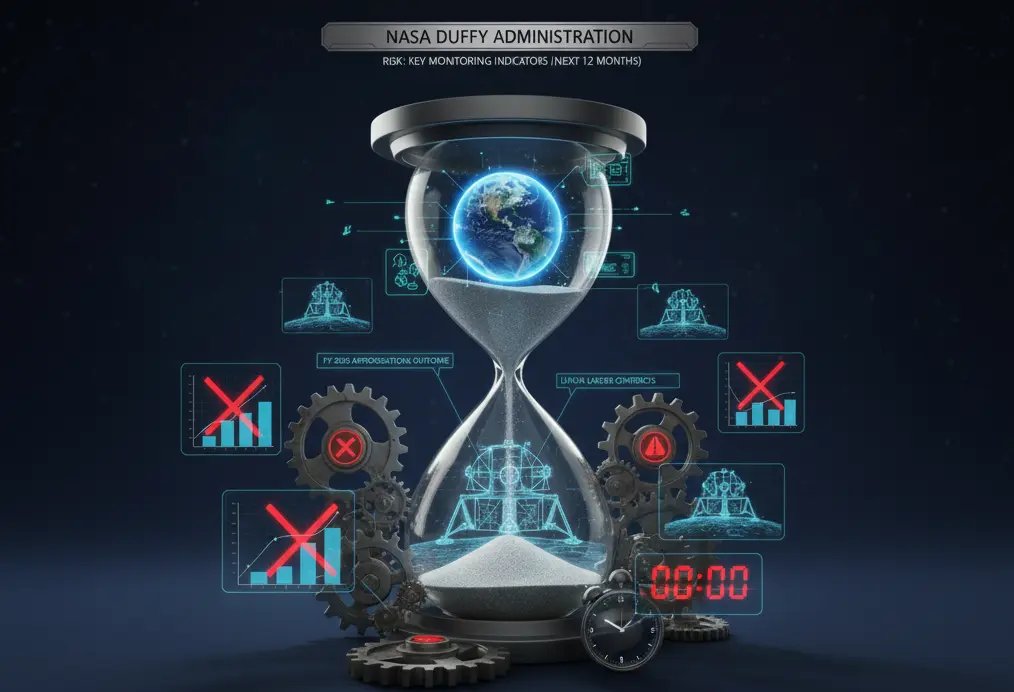Neutral analytical summary; data drawn from public NASA budget documents, industry filings, and independent technical reporting.
Earth Science Missions
Scope affected:
- Orbiting Carbon Observatory-3 (OCO-3)
- PACE (Plankton, Aerosol, Cloud, ocean Ecosystem)
- NISAR (NASA-ISRO Synthetic Aperture Radar) follow-ons
- CLARREO Pathfinder and related climate calibration efforts
- Future missions under the Earth System Observatory umbrella
Observed or proposed actions:
- FY-2026 proposal cuts Earth Science Division budget by ≈ 25 %.
- Program redirection toward “exploration-related science” stated publicly by Acting Administrator.
- Staffing freeze within several Earth Science divisions; deferred solicitations for future instruments.
Technical risks (short–medium term):
| Risk | Description | Likelihood | Impact | Mitigation path |
|---|---|---|---|---|
| Data continuity gap | Gaps in essential climate variable (ECV) records if OCO-3 and PACE successors delayed | High | High (loss of time-series integrity) | Restore multi-year funding lines; maintain partnerships with NOAA/ESA/ISRO |
| Instrument development stagnation | Deferred procurement may cause supplier attrition | Medium | Medium | Maintain tech-base grants to retain vendor capabilities |
| Talent attrition | Scientists/engineers redeployed or exit agency | Medium–High | Medium–High | Protect key teams via targeted retention programs |
| Inter-agency dependency | Increased reliance on foreign or commercial data | Medium | Variable | Establish open-data MOUs with partners |
Net technical rating:
High institutional risk if cuts persist beyond one budget cycle; recovery time for lost observational capacity estimated 5–8 years.
Artemis & Human Exploration Programs
Scope affected:
- Artemis III Lunar Landing System (SpaceX HLS, potential competitors)
- Gateway modules (HALO, PPE)
- SLS and Orion production cadence
- Lunar surface infrastructure and suits contracts
Observed or proposed actions:
- Decision to reopen lunar lander competition; possible new Requests for Proposals (RFPs).
- Public statements prioritizing schedule acceleration to beat China’s planned crewed lunar landing.
- Budget realignment favoring human exploration accounts.
Technical risks (short–medium term):
| Risk | Description | Likelihood | Impact | Mitigation path |
|---|---|---|---|---|
| Schedule slippage from recompete | New procurement cycles can delay integration/testing by ≥ 18 months | High | High | Overlapping source selection with ongoing hardware readiness; maintain fallback baseline |
| Interface divergence | Multiple lander designs may require re-baselining Gateway docking standards | Medium | Medium | Strict configuration control & early interface definition |
| Safety-culture degradation | “Speed over caution” ethos may pressure test regimes | Medium | High | Independent Flight Readiness Review authority retention |
| Industrial base uncertainty | Redistribution of contracts can disrupt supplier continuity | Medium | Medium | Staged competition; ensure minimum build continuity |
| Cost growth from redundancy | Multiple parallel developments increase overhead | Medium | Medium | Cap incremental R&D funding; consolidate post-down-select |
Net technical rating:
Moderate programmatic risk — possible near-term delay but potential long-term benefit from diversified contractor base, contingent on disciplined configuration management.
Cross-cutting Considerations
| Area | Observation | Technical relevance |
|---|---|---|
| Workforce & morale | Workforce reports of uncertainty may slow decision cycles | Can translate into slower design reviews & approvals |
| Systems engineering bandwidth | Dual-agency leadership may reduce high-level attention span | Risk of oversight gaps |
| International partnerships | Program redirection may alter commitments with ESA, JAXA, ISRO | Requires diplomatic & interface renegotiations |
| Data-policy coherence | Shift away from Earth science may weaken NASA’s contribution to U.N. and WMO frameworks | Could degrade interoperability and validation of global models |
Overall Assessment (as of Oct 2025)
| Category | Composite Risk Level | Comment |
|---|---|---|
| Earth Science Division | High | Sustained funding cuts threaten observational continuity; recovery time long. |
| Human Exploration (Artemis) | Moderate | Managerial turbulence and potential delay; technical capabilities intact if oversight maintained. |
| Institutional / Cross-Program | Medium–High | Cultural and resource imbalances may erode system engineering depth. |
Key Monitoring Indicators (next 12 months)
- FY-2026 appropriations outcome (final Congressional language).
- Award announcements for new lunar lander contracts.
- Staffing trendlines within Earth Science and Systems Engineering divisions.
- Status of ongoing missions’ follow-on procurements (PACE-2, CLARREO successor).
- Frequency of independent safety and readiness reviews.



